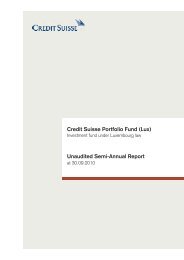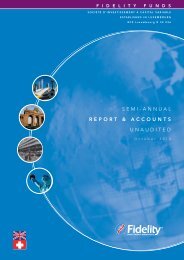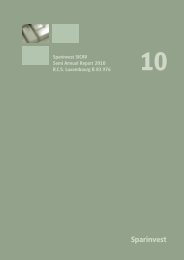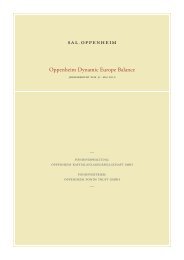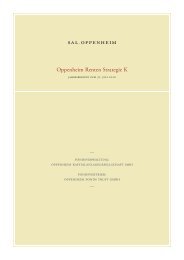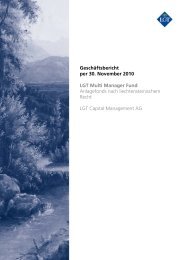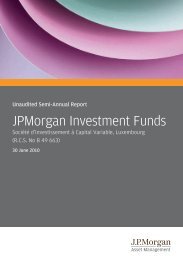Verkaufsprospekt
Verkaufsprospekt
Verkaufsprospekt
Sie wollen auch ein ePaper? Erhöhen Sie die Reichweite Ihrer Titel.
YUMPU macht aus Druck-PDFs automatisch weboptimierte ePaper, die Google liebt.
gression of earnings. The Sub-Fund will strive to add value<br />
by identifying stocks with superior sustainable earnings<br />
performance. The stock selection will also be influenced by<br />
valuation levels, but only to the extent that factors have<br />
been identified which are expected to drive valuation potential<br />
to be realised in terms of earnings progression.<br />
On a regional basis, the investment universe is categorised<br />
according to growth potential. This classification<br />
process incorporates the background of each company's<br />
historical growth patterns, resulting in an informed assessment<br />
of future prospects.<br />
Companies in the investment universe will be classified as<br />
follows:<br />
1. Exceptional growth prospects (normally, relatively<br />
new companies or companies going through radical transformation).<br />
2. High and stable growth.<br />
3. High but cyclical growth.<br />
4. Low or no growth, which are sub-divided into (a)<br />
stable, (b) cyclical and (c) turn-around situation.<br />
Distinct quantitative and qualitative criteria are set forth for<br />
buy and sell decisions.<br />
The Sub-Fund may, within the limits laid down by the Central<br />
Bank, invest in equity and equity-related securities<br />
including but not limited to common stock, preferred stock<br />
and securities which are convertible into or exchangeable<br />
for such equity securities, or which carry warrants to purchase<br />
such equity securities.<br />
The Sub-Fund may, within the limits laid down by the Central<br />
Bank, purchase and sell equity index and equityrelated<br />
instruments including but not limited to LEPOs,<br />
OPALS, PERLES (as outlined in the main body of the<br />
Prospectus), participatory receipts / participatory certificates<br />
and share index notes, each of which may assist in<br />
achieving the investment objective of the Sub-Fund.<br />
Where utilised, LEPOs, OPALS and PERLES will be listed<br />
or traded on one or more of the stock exchanges or recognised<br />
markets on which the Sub-Fund is permitted to invest,<br />
as set out in Appendix I to the Prospectus. These<br />
instruments shall in each case comprise transferable securities<br />
of the issuer, notwithstanding that their value is linked<br />
to an underlying equity or equity index. In practice, the<br />
Sub-Fund will purchase such instruments from an issuer<br />
and the instrument will track the underlying equity or equity<br />
index. It should be noted that the Sub-Fund's exposure in<br />
relation to these instruments will be to the issuer of the<br />
instruments. However, the Sub-Fund will also have an<br />
economic exposure to the underlying securities themselves.<br />
Any LEPOs purchased or sold by the Sub-Fund will<br />
be exercisable at any time over the duration of its life and<br />
may be settled on a cash basis.<br />
The Sub-Fund may invest in American, International, and<br />
Global Depository Receipts (ADRs / IDRs / GDRs) which<br />
are listed on a Recognised Exchange as set out in Appendix<br />
I to the Prospectus. Such investments must be in accordance<br />
with the investment objective, investment policy<br />
and investment restrictions of the Sub-Fund.<br />
PineBridge Asia Balanced Fund<br />
The Sub-Fund may invest up to 10% of its Net Asset Value<br />
in regulated collective investment schemes, including real<br />
estate investment trusts (REITs), where the investment<br />
policies of these schemes are consistent with that of the<br />
Sub-Fund and such schemes meet the criteria set out in<br />
Guidance Note 2/03. The ability to trade REITs in the<br />
secondary market can be more limited than other stocks.<br />
The Sub-Fund may, within the limits laid down by the Central<br />
Bank, hold cash and / or ancillary liquid assets and<br />
may invest in money market instruments (as defined in the<br />
Central Bank's Notices and which may or may not be dealt<br />
on a regulated market), which are rated investment grade<br />
by an international rating agency. Such money market<br />
instruments may include but are not limited to nongovernment<br />
short term obligations (such as fixed or floating<br />
rate commercial paper), obligations of banks or other<br />
depository institutions (such as certificates of deposit and<br />
bankers acceptances), securities issued or otherwise<br />
backed by supranational organisations or by sovereign<br />
governments, their agencies, their instrumentalities and<br />
political sub divisions.<br />
The Sub-Fund may, within the limits laid down by the Central<br />
Bank, hold deposits with credit institutions as prescribed<br />
in the Central Bank’s Notices.<br />
Where considered appropriate, the Sub-Fund may utilise<br />
collateralised debt obligations ("CDO"), credit default<br />
swaps ("CDS"), or credit linked notes ("CLN") for investment<br />
purposes or for hedging purposes, including protection<br />
against credit or default risks, subject to the conditions<br />
and within the limits laid down by the Central Bank. Such<br />
investments must be in accordance with the investment<br />
objectives, investment policy and investment restrictions of<br />
the Sub-Fund.<br />
A CDO is a security backed by a pool of bonds, loans and<br />
other assets. CDOs do not specialize in one type of debt<br />
and accordingly, a CDO may own corporate bonds, commercial<br />
loans, asset-backed securities, residential mortgage-backed<br />
securities, commercial mortgage-backed<br />
securities, and emerging market debt. The CDO's securities<br />
are typically divided into several classes, or bond<br />
tranches, that have differing levels of investment grade or<br />
credit tolerances. Most CDO issues are structured in a way<br />
that enables the senior bond classes and mezzanine<br />
classes to receive investment-grade credit ratings; credit<br />
risk is shifted to the most junior class of securities. If any<br />
defaults occur in the assets backing a CDO, the senior<br />
bond classes are first in line to receive principal and interest<br />
payments, followed by the mezzanine classes and<br />
finally by the lowest rated (or non-rated) class, which is<br />
known as the equity tranche. The Sub-Fund will invest in<br />
the rated or equity tranches of CDOs and will not be leveraged<br />
as result of such investments.<br />
A CDS is a FDI which operates to mitigate credit risk. The<br />
protection buyer purchases protection from the protection<br />
seller for losses that might be incurred as a result of a<br />
default or other credit event in relation to an underlying<br />
security. The protection buyer pays a premium for the<br />
protection and the protection seller agrees to make a payment<br />
to compensate the protection buyer for losses incurred<br />
upon the occurrence of any one of a number of<br />
| 59



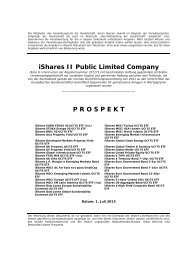
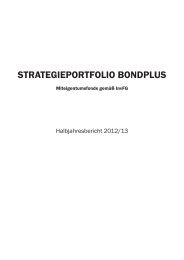

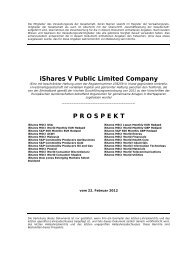
![Prospectus Simplifié daté de [Mars] 2005](https://img.yumpu.com/18875582/1/190x245/prospectus-simplifie-date-de-mars-2005.jpg?quality=85)

